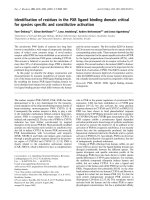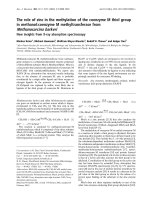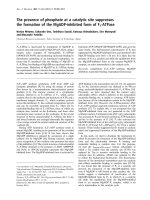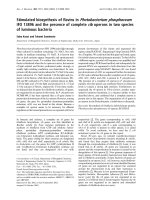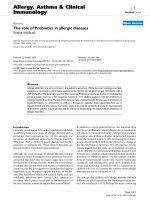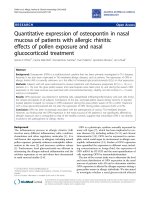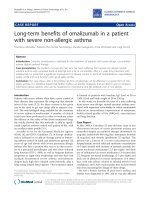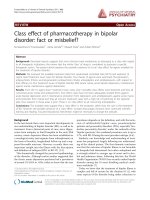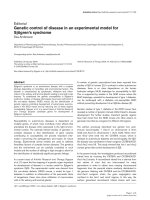Báo cáo y học: "Long-term benefits of omalizumab in a patient with severe non-allergic asthma" ppt
Bạn đang xem bản rút gọn của tài liệu. Xem và tải ngay bản đầy đủ của tài liệu tại đây (224.76 KB, 4 trang )
CAS E REP O R T Open Access
Long-term benefits of omalizumab in a patient
with severe non-allergic asthma
Francesco Menzella
*
, Roberto Piro, Nicola Facciolongo, Claudia Castagnetti, Anna Simonazzi and Luigi Zucchi
Abstract
Introduction: Currently, omalizumab is indicated for the treatment of patients with severe allergic uncontrolled
asthma despite optimal therapy.
Case presentation: We studied a 52-year-old man who has been suffering from severe non allergic steroid-
resistant asthma with increased levels of total IgE and a lot of comorbidity. After a 3 years long treatment with
omalizumab, he presented a significant improvement in disease control in terms of hospitalizations, exacerbation,
quality of life and lung function with good safety profile.
Conclusion: Our case shows, after a long follow-up, how omalizumab can be effective in a severe form of non-
atopic asthma. It is therefore hoped that further studies can identify indicators that are able to give to clinicians
information about patients who can be responsive to monoclonal anti-IgE antibody even if non allergic.
Introduction
Patients with severe asthma often have a poor control of
their disease; they represent the subgroup that absorbs
most of the costs [1,2]; for these reasons it has given
rise to the need to get new drugs able to improve con-
trol. The only biological drug available for the treatment
of severe asthma is omalizumab. A number of c linical
trials have been performed in order to evaluate either
the efficacy or the safety of the above-mentioned drug:
the result s showed that this molecule is able to signifi-
cantly i mprove asthma control and quality of life, with
an excellent safety profile [3-5].
Actually, as set by the European Medicine Agency
(EMA) [6] and GINA Guidelines [7], in Europe omalizu-
mab is indicated as an add-on therapy aimed at improv-
ing asthma control in adult and adolescent patients (12
years of age and above) with severe persistent allergic
asthma who have a positive skin test or in vitro react iv-
ity to a perennial aeroallergen and who show reduced
lung func tion (FEV1 <80%) as well as frequent daytime
symptoms or night-time awakenings and who have had
multiple documented severe asthma exacerbations
despite daily hi gh-dose inhaled cortico steroids, plus a
long-acting inhaled beta2-agonist. This treatment option
is limited to patients with baseline IgE level o f 30 to
1.500 IU/ml and body weight of 20 to 150 kg.
In this study we describe the case of a man suffering
from severe non-allergic steroid-resista nt asthma asso-
ciated with important comorbidity in which omalizumab
induced an extraordinary improvement of symptoms,
health-related quality of life (HRQoL), exacerbations
and lung function.
Case Report
In May 2006 a Caucasian 52-year-old man came to our
observation because of severe persistent asthma not
controlled despite an extensive therapy (formoterol 18
mcg/day; budesonide 640 mcg/day; tiotro pium bromide
18 mcg/day), oral steroids (prednisone 25 mg/day). The
patient has a history of 2 severe exacerbations with
hospitalization, several mild and moderate exacerbations
(4-5/year ) treated with incre ase of systemic steroids, fre-
quent nocturnal awakenings (2-3 per night) and daily
use of salbutamol as rescue medication (3-4 times/day)
[7], frequent nocturnal awakenings (2-3 per night) and
daily use of a lbuterol as rescue medication (3-4 times/
day) with side effects related to inhaled steroid (oral
candidiasis) and LABA (tachycardia) that had prevented
him from increasing the dosage of these drugs.
He was a former smoker (9 pack-year), asthma and
rhinitis were diagnosed in 1991 and he was also affected
* Correspondence: e.it
Department of Respiratory Diseases, Santa Maria Nuova Hospital, Reggio,
Emilia, Italy
Menzella et al. Allergy, Asthma & Clinical Immunology 2011, 7:9
/>ALLERGY, ASTHMA & CLINICAL
IMMUNOLOGY
© 2011 Menzella et al; li censee BioMed Central Ltd. This is an Open Access article distributed under the terms of the Creative
Commons Attribu tion License ( 2.0), which permits unrestrict ed use, distribution, and
reproduction in any medium, provided the origina l work is properly cited.
by nasal polyps, hypertension, diverticulosis of the colon,
moderate ob esity, dyslipidemia and lactose intolerance.
He was hospitalized in the Respiratory Department
because of asthma exacerbation in 2004 and 2005. The
patient was not sensitized to aero- and food allergens
and his respiratory symptoms were not affected by sea-
sons. Vesicular breath sounds were markedly reduced
and wheezes were present. Lung function tests showed a
severe obstruction: FEV1 1.52 (46% of predicted) and
FEV1/FVC 0.41 [Table 1]. The ventilatory defect showed
reversibility (23%) after albuterol administration. A high-
resolution chest CT showed no signs of parenchymal
lung disease. Blood tests showed peripheral eosinophilia
(8%) and total IgE were 272 .6 KIU/L without specific
IgE to inhalant or food allergens testing with Immuno-
Cap (Phadia, Sweden).
Even the skin prick test for common aeroallergens
was negative. The allergens we performed (both for
cutaneous and serological tests) were: grasses , parietaria
officinalis, ragweed, mugwort, plantain, birch, cypress,
walnut, dust mites, molds ( Aspergillus Fumigatus,
Alternaria, Cladosporium, Penicillium), cat and dog
epithelium.
We used the Asthma Quality of Life Questionnaire
(AQLQ) [8] to assess the patient’s QoL with an initial
score of 1,71 points, indicating a poor HRQoL [Table
1]. Given the poor asthma control, the severe obstruc-
tion and t otal IgE, we hypothesized that treatment with
omalizumab could be effective, despite the absence of
sensitization to inhalant allergens.
The patient signed the informed consent and started
the treatment in July 2006 (300 mg every 15 days subcu-
taneously). An improvement in symptoms of asthma
control was evident after only 16 weeks of treatment;
the patient had no exacerbation. The lung function
parameters were essentially unchanged but the AQLQ
score increased to 3.23 [Table 1].
In order to evaluate the efficacy of omalizumab, the
Global Evaluation of Treatment Effectiveness scales
(GETE) [3,9,10] was used and the result was good. After
32 weeks of t reatment the discontinuation of systemic
steroid and tiotropium was possible. In that interval,
there had been no exacerbations; spirometry showed a
slight worsening (FEV1 1.33 l), while the AQLQ score
was further improved (4.62). The GETE was excellent.
The patient was fol lowed until July 2010 and in that
range he had only two mild relapses and no hospitaliza-
tion. The AQLQ score arrived at 5.43 confirming a
marked improvement in the quality of lif e; spirometry
showed a discrete increase (FEV1 1.70 l; 53% of pre-
dicted) compared to baseline(FEV1+15%).TheGETE
was confirmed excellent [Table 1].
Finally, the assay of serum IgE at the end of follow-up
was 419 IU/ml, with an increase compared to baseline.
Discussion
According to current guidelines, omalizumab is a safe
and effective add-on treatment which, in suitable
patients [7], allows them to obtain better control of
asthma by reducing the number of exacerbations and
the use of steroids and improving the quality of life
[3,4].
Actually, one only report [11] concerns the effective-
ness of this drug in a patient with non-allergic asthma
(who had high total IgE). Several authors showed that
the different phenotypes of asthma have several likeness,
with similar cytokine and cellular patterns both in aller-
gic and non-allergic asthma [12,13]. There fore, IgE may
have a key role in the inflammatory cascade (even in
the absence of a proved aeroallergen) contributing to
bronchial hyper reactivity and remodeling in asthma.
Also, it is well known that higher values of IgE are asso-
ciated with higher hyper reactivity and more severe
obstruction [14].
Table 1 Omalizumab treatment effectiveness
Outcomes Basal Basal (post
beta agonist)
32-week 3-years 3-years (post
beta agonist)
GETE rating Excellent Excellent
AQLQ
(median, range)
1.71 3.23 5.43
FEV1 % 46% 60% 40% 53% 71%
FEV1/FVC 0.49 0.49 0.46 0.49 0.57
FEF25% 25% 30% 12% 26% 33%
FEF50% 15% 18% 13% 18% 22%
FEF75% 16% 14% 13% 13% 15%
Hospitalization 2 0 0
Exacerbation mild + moderate 5 for year 0 2 (-60%)
IgE 272.6 IU/ml 419 IU/ml
Menzella et al. Allergy, Asthma & Clinical Immunology 2011, 7:9
/>Page 2 of 4
However, it was shown that the block of free IgE is
not the only pharmacological effect of omalizumab, as it
also prom otes the down-regulation of the expression of
the high-affinity receptor FcεRI, causing a further reduc-
tion of IgE on the cell surface [14,15].
Also, a study by Berger and cohautors showed that the
in vitro incubation with omalizumab of bronchial tissue
from asthmatic patients, inhibits specific and aspecific
bronchial hyper-responsiveness. This effect should be
related to the inhibition of bronchial mast-cells degranu-
lation [16].
Based on these considerations, we hypothesized that
treatment with omalizumab in our patient could be
effective, in spite of what is indicated by the guidelines
and the manufacturer.
The clinical and instrumental data show a significant
improvement in disease control in term s of hospitaliza-
tions and exacerbations. In order to evaluate the effec-
tiveness at 32 weeks and at 3 years, we used the Global
Evaluation of Treatment Effectiveness scale (GETE)
[3,9,10]. The evaluation is performed independently by
both investigator and patient using the same 5 point
scale. This scale ranges from excellent through good,
moderate, and poor to worsening. A good or excellent
response is suggested as a means of defining a patient
who has responded to treatment. In our patient the
GETE rating at 3 years was excellent, confirming the
effectiveness of omalizumab.
Health-related quality of life (HRQoL) was assessed
by means of the AQLQ score [8]. The AQLQ is com-
posed of 32 questions which cover four domains:
activity limitatio n, symptoms, environmental stimuli
and emotional function. Subjects recall their experi-
ences during the previous 2 weeks and score a number
of asthma-related problems on a 7-point scale from 1
(maximum impairment) to 7 (no impairment). We
used an overall summary index, which is the mean of
the responses to the 32 items (total AQLQ score). The
AQLQ was found to be valid, reproducible and
responsive to change over time and a change in
questionnaire score of 0.5 or more points has been
determined to be the minimal clinically important dif-
ference [8]. In our patient the quality of life improved
significantly, with the AQLQ score progressively
increasing over time. The lung function parameters
were stable during the first months, showing a rise
after four years. This could be explained by the bron-
chial remodelling caused by t he long-standing ashtma,
which needed several months of therapy t o appreciate
an improvement.
In our study, it is possible that specific allergic sensi-
tivity was simply not identified, as the range of potential
allergenic agents is considerably larger than current
diagnostic reagents can address, so false-negative aller-
gen-skin-test results are likely to happen.
Also, in this patient the contribution of placebo effects
cannot be excluded. However, improvements were seen
in objective parameters such as lung functio n and nu m-
ber of exacerbations as well as symptom improvement.
The possibility that the improvement is related to a
greater surveillance is unlikely as it was previously fol-
lowed consistently with good compliance. In addition,
the timing are closely related with the administration of
omalizumab.
AbouttheincreaseoftotalIgE,itiswell-knownthat
patients treated with omalizuma b may exhibit reduction
of serum free IgE levels with increased total IgE due to
the formatio n of IgE anti-IgE small immune compl exes,
which have a longer half-life than free IgE [17,18]. How-
ever, this increase has not pathological significance.
In conclusion, our work shows after a long follow-up
the effectiveness of omalizumab with a good safety profile
inasevereformofnon-atopicasthmawithincreased
levels of total IgE. It is therefore hoped that f urther stu-
dies identify new indicators that can give to clinicians
information about asthmatic patients who can be respon-
sive to monoclonal anti-IgE antibody even if non allergic.
Consent
Written informed consent was obtained from the patient
for publication of this case report.
Abbreviations
AQLQ: Asthma Quality of Life Questionnaire; FEV1: Forced Expiratory Volume
in 1 Second; FVC: Forced Ventilatory Capacity; GETE: Global Evaluation of
Treatment Effectiveness; GINA: Global Initiative for Asthma; IgE:
Immunoglobulin E; QoL: Quality of Life
Authors’ contributions
FM coordinated diagnostic and therapeutic stages and was one of the
principal contributors in writing the manuscript. RP contributed to the
clinical approach, analyzed and interpreted the data and was a major
contributor in writing the manuscript. NF was a contributor in writing the
manuscript. CC was a contributor in writing the manuscript. AS was a
contributor in writing the manuscript. LZ was a contributor in writing the
manuscript and he gave final approval of the version to be published. All
authors read and approved the final manuscript.
Authors’ information
The Centre the authors belong to participated in the last International
Clinical Trial on omalizumab (CIGE025A2425) as National Coordinating
Centre for Italy.
Competing interests
FM participated in clinical trial for Novartis and received travel sponsorship
from Novartis, Astra-Zeneca e Glaxo Smith-Kline. NF received travel
sponsorship from Astra-Zeneca, Pfizer, Boehringer. CC received travel
sponsorship from Nycomed, Astra-Zeneca. LZ received travel grant from
Novartis, Astra-Zeneca, Glaxo Smith- Kline and participated in contracted
research for Novartis, Glaxo Smith-Kline, Boehringer-Ingelheim.
Received: 21 January 2011 Accepted: 24 May 2011
Published: 24 May 2011
Menzella et al. Allergy, Asthma & Clinical Immunology 2011, 7:9
/>Page 3 of 4
References
1. National Heart, and Blood Institute: Morbidity and mortality: 2002.
Bethesda (MD) National Heart, Lung, and Blood Institute; 2002.
2. European Lung White Book: The first comprehensive survey on
respiratory health in Europe. In European Respiratory Society. Edited by:
Loddenkemper R, Gibson GJ, Sybille Y. Sheffield: ERSJ; 2003:16-25.
3. Humbert M, Beasley R, Ayres J, Slavin R, Hébert J, Bousquet J, Beeh KM,
Ramos S, Canonica GW, Hedgecock S, Fox H, Blogg M, Surrey K: Benefits of
omalizumab as add-on therapy in patients with severe persistent
asthma who are inadequately controlled despite best available therapy
(GINA 2002 step 4 treatment): INNOVATE. Allergy 2005, 60(3):309-16.
4. Rodrigo GJ, Neffen H, Castro-Rodriguez JA: Efficacy and safety of
subcutaneous omalizumab versus placebo ad add on therapy to
corticosteroids for children and adults with asthma: a systematic review.
Chest 2011, 139(1):28-35.
5. Walker S, Monteil M, Phelan K, Lasserson TJ, Walters EH: Anti-IgE for
chronic asthma in adults and children. Cochrane Database of Systematic
Reviews 2006, , 2: CD003559.
6. European Medicine Agency (EMA)- Xolair. [ />ema/index.jsp?curl=pages/medicines/human/medicines/000606/
human_med_001162.jsp&murl=menus/medicines/medicines.
jsp&jsenabled=true].
7. GINA Global Strategy for Asthma Management and Prevention, 2006
NHI Publications No 02-3659. GINA update 2009 [asthma.
org].
8. Juniper EF, Guyatt GH, Ferrie PJ, Ferrie PJ, Griffith LE, Townsend M:
Measuring quality of life in asthma. Am Rev Respir Dis 1993, 147:832-8.
9. Lloyd Andrew, Turk Florian, Leighton Trevor, Canonica GW: Psychometric
evaluation of Global Evaluation of Treatment Effectiveness: a tool to
assess patients with moderate-to-severe allergic asthma. Journal of
Medical Economics 2007, 10(3):285-296.
10. Brusselle G, Michils A, Louis R, Dupont L, Van de Maele B, Delobbe A,
Pilette C, Lee CS, Gurdain S, Vancayzeele S, Lecomte P, Hermans C,
MacDonald K, Song M, Abraham I: “Real-life” effectiveness of omalizumab
in patients with severe persistent allergic asthma: The PERSIST study.
Respir Med 2009, 103(11):1633-42.
11. Van den Berge M, Pauw RG, de Monchy JGR, van Minnen CA, Postma DS,
Kerstjens HA: Beneficial effects of treatment with anti-IgE antibodies
(omalizumab) in a patient with severe asthma and negative skin-prick
test results. Chest 2011, 139:190-193.
12. Humbert M, Durham SR, Kimmitt P, Powell N, Assoufi B, Pfister R, Menz G,
Kay AB, Corrigan CJ: Elevated expression of messenger ribonucleic acid
encoding IL-13 in the bronchial mucosa of atopic and non atopic
subjects with asthma. J Allergy Clin Immunol 1997, 99(5):657-665.
13. Beeh KM, Ksoll M, Buhl R: Elevation of total serum immunoglobulin E is
associated with asthma in non allergic individuals. Eur Respir J 2000,
16(4):609-614.
14. Holgate ST, Djukanovic R, Casale T, Bousquet J: Anti-immunoglobulin E
treatment with omalizumab in allergic diseases: an update on anti-
inflammatory activity and clinical efficacy. Clin Exp Allergy 2005,
35:408-416.
15. MacGlashan DW Jr, Bochner BS, Adelman DC, Jardieu PM, Togias A,
McKenzie-White J, Sterbinsky SA, Hamilton RG, Lichtenstein LM: Down-
regulation of FceRI expression on human basophils during in vivo
treatment of atopic patients with anti-IgE antibody. J Immunol 1997,
158:1438-45.
16. Berger P, Scotto-Gomez E, Molimard M, Marthan R, Le Gros V, Tunon-de-
Lara JM: Omalizumab decreases non-specific airway
hyperresponsiveness. Allergy 2007, 62:154-161.
17. Hayashi N, Tsukamoto Y, Sallas WM, Lowe PJ: A mechanism-based binding
model for the population pharmacokinetics and pharmacodynamics of
omalizumab. Br J Clin Pharmacol 2006, 63:548-61.
18. Hamilton RG, Marcotte GV, Saini SS: Immunological methods for
quantifying free and total serum IgE levels in allergy patients receiving
omalizumab (Xolair) therapy. J Immunol Methods 2005, 303:81-91.
doi:10.1186/1710-1492-7-9
Cite this article as: Menzella et al.: Long-term benefits of omalizumab in
a patient with severe non-allergic asthma. Allergy, Asthma & Clinical
Immunology 2011 7:9.
Submit your next manuscript to BioMed Central
and take full advantage of:
• Convenient online submission
• Thorough peer review
• No space constraints or color figure charges
• Immediate publication on acceptance
• Inclusion in PubMed, CAS, Scopus and Google Scholar
• Research which is freely available for redistribution
Submit your manuscript at
www.biomedcentral.com/submit
Menzella et al. Allergy, Asthma & Clinical Immunology 2011, 7:9
/>Page 4 of 4

